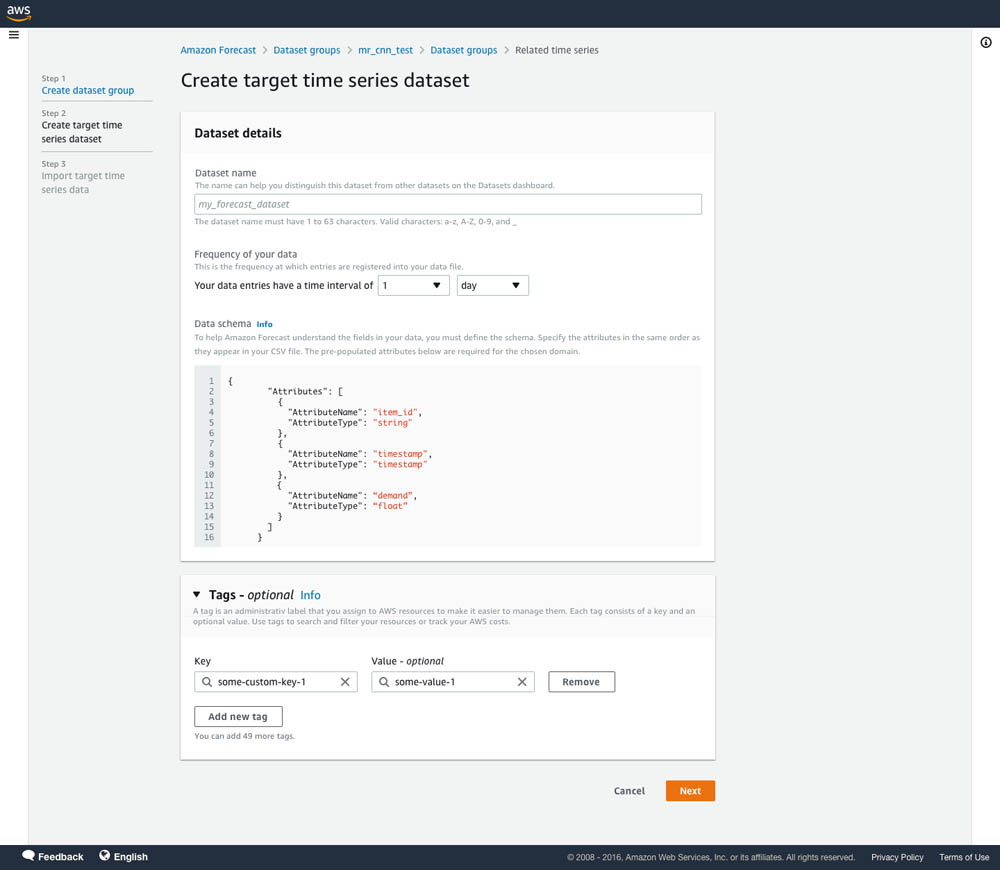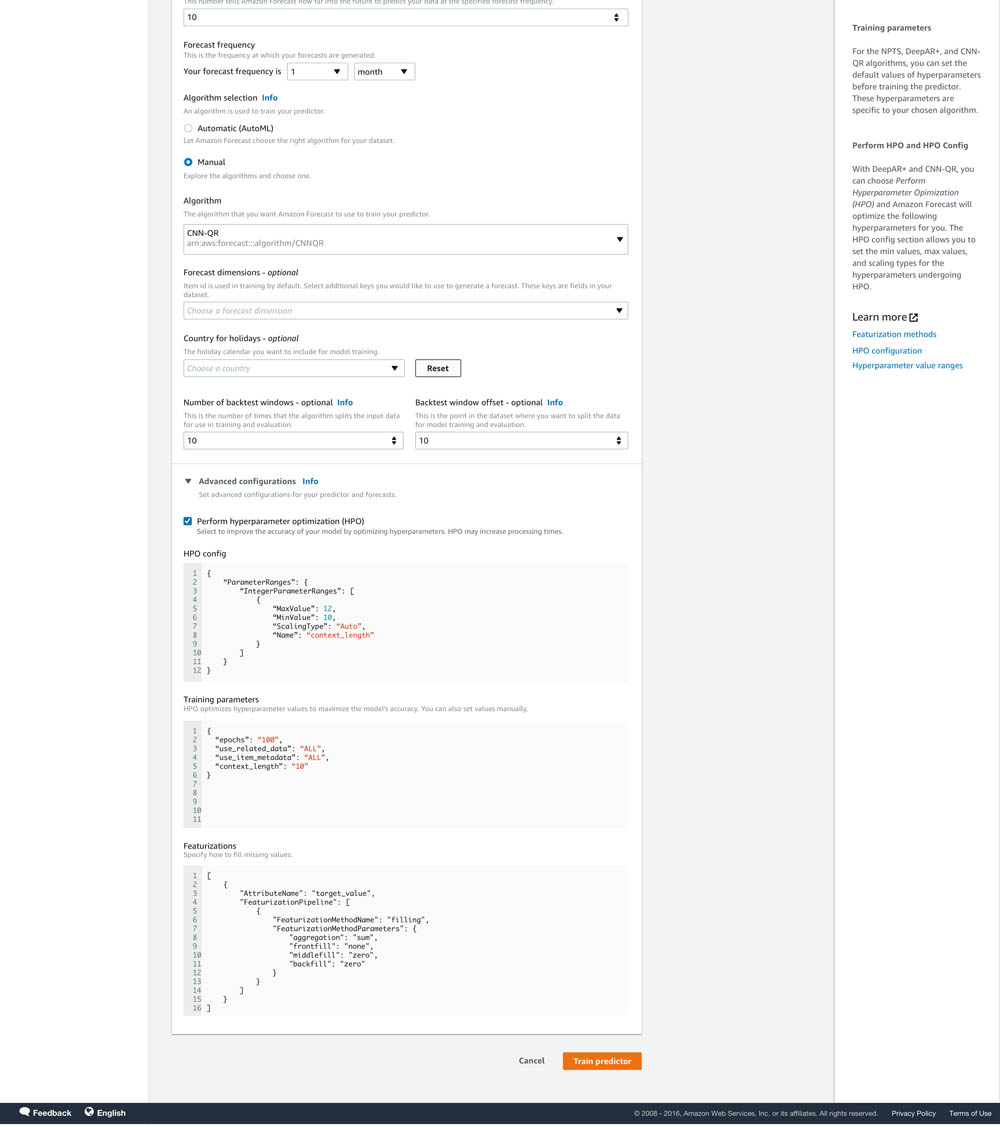We’re excited to announce that Amazon Forecast can now use Convolutional Neural Networks (CNNs) to train forecasting models up to 2X faster with up to 30% higher accuracy. CNN algorithms are a class of neural network-based machine learning (ML) algorithms that play a vital role in Amazon.com’s demand forecasting system and enable Amazon.com to predict demand for over 400 million products every day. For more information about Amazon.com’s journey building demand forecasting technology using CNN models, watch the re:MARS 2019 keynote video. Forecast brings the same technology used at Amazon.com into the hands of everyday developers as a fully managed service. Anyone can start using Forecast, without any prior ML experience, by using the Forecast console or the API.
Forecasting is the science of predicting the future. By examining historical trends, businesses can make a call on what might happen and when, and build that into their future plans for everything from product demand to inventory to staffing. Given the consequences of forecasting, accuracy matters. If a forecast is too high, businesses over-invest in products and staff, which ends up as wasted investment. If the forecast is too low, they under-invest, which leads to a shortfall in inventory and a poor customer experience. Today, businesses try to use everything from simple spreadsheets to complex financial planning software to generate forecasts, but high accuracy remains elusive for two reasons:
- Traditional forecasts struggle to incorporate very large volumes of historical data, missing out on important signals from the past that are lost in the noise.
- Traditional forecasts rarely incorporate related but independent data, which can offer important context (such as sales, holidays, locations, and marketing promotions). Without the full history and the broader context, most forecasts fail to predict the future accurately.
At Amazon, we have learned over the years that no one algorithm delivers the most accurate forecast for all types of data. Traditional statistical models have been useful in predicting demand for products that have regular demand patterns, such as sunscreen lotions in the summer and woolen clothes in the winter. However, statistical models can’t deliver accurate forecasts for more complex scenarios, such as frequent price changes, differences between regional versus national demand, products with different selling velocities, and the addition of new products. Sophisticated deep learning models can provide higher accuracy in these use cases. Forecast automatically examines your data and selects the best algorithm across a set of statistical and deep learning algorithms to train the more accurate forecasting model for your data. With the addition of the CNN-based deep learning algorithm, Forecast can now further improve accuracy by up to 30% and train models up to 2X faster compared to the currently supported algorithms. This new algorithm can more accurately detect leading indicators of demand, such as pre-order information, product page visits, price changes, and promotional spikes, to build more accurate forecasts.
More Retail, a market leader in the fresh food and grocery category in India, participated in a beta test of the new CNN algorithm, with the help of Ganit, an analytics partner. Supratim Banerjee, Chief Transformation Officer at More Retail Limited, says, “At More, we rapidly innovate to sustain our business and beat competition. We have been looking for opportunities to reduce wastage due to over stocking, while continuing to meet customer demand. In our experiments for the fresh produce category, we found the new CNN algorithm in Amazon Forecast to be 1.7X more accurate compared to our existing forecasting system. This translates into massive cost savings for our business.”
Training a CNN predictor and creating forecasts
You can start using CNNs in Forecast through the CreatePredictor API or on the Forecast console. In this section, we walk through a series of steps required to train a CNN predictor and create forecasts within Forecast.
- On the Forecast console, create a dataset group.

- Upload your dataset.

- Choose Predictors from the navigation pane.
- Choose Train predictor.

- For Algorithm selection, select Manual.
- For Algorithm, choose CNN-QR.

To manually select CNN-QR through the CreatePredictor API, use arn:aws:forecast:::algorithm/CNN-QR for the AlgorithmArn.
When you choose CNN-QR from the drop-down menu, the Advanced Configuration section auto-expands.
- To let Forecast train the most optimized and accurate CNN model for your data, select Perform hyperparameter optimization (HPO).
- After you enter all your details on the Predictors page, choose Train predictor.

After your predictor is trained, you can view its details by choosing your predictor on the Predictors page. On the predictor’s details page, you can view the accuracy metrics and optimized hyperparameters for your model.

- Now that your model is trained, choose Forecasts from the navigation name.
- Choose Create a forecast.
- Create a forecast using your trained predictor.
You can generate forecasts at any quantile to balance your under-forecasting and over-forecasting costs.

Choosing the most accurate model with Forecast
With this launch, Forecast now supports one proprietary CNN model, one proprietary RNN model, and four other statistical models: Prophet, NPTS (Amazon proprietary), ARIMA, and ETS. The new CNN model is part of AutoML. We recommend always starting your experimentation with AutoML, in which Forecast finds the most optimized and accurate model for your dataset.
- On the Train predictor page, for Algorithm selection, select Automatic (AutoML).

- After your predictor is trained using AutoML, choose the predictor to see more details on the chosen algorithm.
- On the predictor’s details page, in the Algorithm metrics section, choose different algorithms from the drop-down menu to view their accuracy for comparison.

Tips and best practices
As you begin to experiment with CNNs and build your demand planning solutions on top of Forecast, consider the following tips and best practices:
- For experimentation, start by identifying the most important item IDs for your business that you are looking to improve your forecasting accuracy. Measure the accuracy of your existing forecasting methodology as a baseline.
- Use Forecast with only your target time series and assess the wQuantileLoss accuracy metric. We recommend selecting AutoML in Forecast to find the most optimized and accurate model for your data. For more information, see Evaluating Predictor Accuracy.
- AutoML optimizes for accuracy and not training time, so AutoML may take longer to optimize your model. If training time is a concern for you, we recommend manually selecting CNN-QR and assessing its accuracy and training time. A slight degradation in accuracy may be an acceptable trade-off for considerable gains in training time.
- After you see an increase in accuracy over your baseline, we recommend experimenting to find the right forecasting quantile that balances your under-forecasting and over-forecasting costs to your business.
- We recommend deploying your model as a continuous workload within your systems to start reaping the benefits of more accurate forecasts. You can continue to experiment by adding related time series and item metadata to further improve the accuracy.
- Incrementally add related time series or item metadata to train your model to assess whether additional information improves accuracy. Different combinations of related time series and item metadata can give you different results.
Conclusion
The new CNN algorithm is available in all Regions where Forecast is publicly available. For more information about Region availability, see Region Table. For more information about the CNN algorithm, see CNN-QR algorithm documentation.
About the authors
 Namita Das is a Sr. Product Manager for Amazon Forecast. Her current focus is to democratize machine learning by building no-code/low-code ML services. She frequently advises startups and has started dabbling in baking.
Namita Das is a Sr. Product Manager for Amazon Forecast. Her current focus is to democratize machine learning by building no-code/low-code ML services. She frequently advises startups and has started dabbling in baking.
 Danielle Robinson is an Applied Scientist on the Amazon Forecast team. Her research is in time series forecasting and in particular how we can apply new neural network-based algorithms within Amazon Forecast. Her thesis research was focused on developing new, robust, and physically accurate numerical models for computational fluid dynamics. Her hobbies include cooking, swimming, and hiking.
Danielle Robinson is an Applied Scientist on the Amazon Forecast team. Her research is in time series forecasting and in particular how we can apply new neural network-based algorithms within Amazon Forecast. Her thesis research was focused on developing new, robust, and physically accurate numerical models for computational fluid dynamics. Her hobbies include cooking, swimming, and hiking.
 Aaron Spieler is a working student in the Amazon Forecast team. He is starting his masters degree at the University of Tuebingen, and studied Data Engineering at Hasso Plattner Institute after obtaining a BS in Computer Science from University of Potsdam. His research interests span time series forecasting (especially using neural network models), machine learning, and computational neuroscience.
Aaron Spieler is a working student in the Amazon Forecast team. He is starting his masters degree at the University of Tuebingen, and studied Data Engineering at Hasso Plattner Institute after obtaining a BS in Computer Science from University of Potsdam. His research interests span time series forecasting (especially using neural network models), machine learning, and computational neuroscience.
 Gunjan Garg: Gunjan Garg is a Sr. Software Development Engineer in the AWS Vertical AI team. In her current role at Amazon Forecast, she focuses on engineering problems and enjoys building scalable systems that provide the most value to end-users. In her free time, she enjoys playing Sudoku and Minesweeper.
Gunjan Garg: Gunjan Garg is a Sr. Software Development Engineer in the AWS Vertical AI team. In her current role at Amazon Forecast, she focuses on engineering problems and enjoys building scalable systems that provide the most value to end-users. In her free time, she enjoys playing Sudoku and Minesweeper.
 Chinmay Bapat is a Software Development Engineer in the Amazon Forecast team. His interests lie in the applications of machine learning and building scalable distributed systems. Outside of work, he enjoys playing board games and cooking.
Chinmay Bapat is a Software Development Engineer in the Amazon Forecast team. His interests lie in the applications of machine learning and building scalable distributed systems. Outside of work, he enjoys playing board games and cooking.
